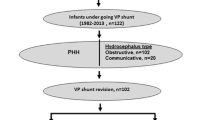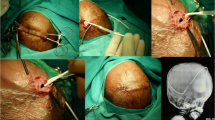Abstract
Among premature infants born at less than 1500 g, the incidence of intraventricular hemorrhage is greater than 45%. Of these, 40% will develop progressive posthemorrhagic hydrocephalus (PPHH). Optimum treatment remains controversial. Ventriculosubgaleal (VSG) shunts were first proposed as a means of temporarily diverting cerebrospinal fluid (CSF) in a more physiological manner for those infants less than 1500 g in weight who would not tolerate a ventriculoperitoneal (VP) shunt. The VSG shunt could then be converted into a VP shunt when the infant had gained the desired weight. Despite favorable reports, the procedure has not gained universal acceptance and is unknown to many neurosurgeons. The present authors report a series of 15 patients who had VSG shunts inserted with excellent temporary CSF diversion and no complications. Furthermore, 3 out of the 15 patients required no further treatment. We suggest that VSG shunting is a safe and effective means of treating the premature infant with PPHH.
Similar content being viewed by others
References
Allan WC, Volpe JJ (1986) Periventricular-intraventricular hemorrhage. Pediatr Clin North Am 26:47–63
Armstrong DL, Sauls CD, Goddar-Finegold J (1987) Neuropathologic findings in short-term survivors of intraventricular hemorrhage. Am J Dis Child 141:617–621
Boynton BR, Boynton CA, Merritt TA, Vaucher YE, James HE, Bejar RF (1986) Ventriculoperitoneal shunts in low birth weight infants with intracranial hemorrhage: neurodevelopmental outcome. Neurosurgery 18:141–145
Drapkin AJ, Levine ME, Yang WC (1980) Ventriculo-subgaleal shunt: evaluation bycomputed tomography. Acta Neurochir 55:107–115
Gurtner P, Bass T, Gudeman SK, Penix JO Philput CB, Schinco FP (1992) Surgical management of posthemorrhagic hydrocephalus in 22 low-birthweight infants. Child's Nerv Syst 8:198–202
Hayden CK, Shattuck KE, Richardson CJ, Ahrendt DK, House R, Swischuk LE (1985) Subependymal germinal matrix hemorrhage in full-term neonates. Pediatrics 75:714–718
Holt PJ (1989) Posthemorrhagic hydrocephalus. J Child Neurol 4:S2-S31
Hudgins RJ, Boydston WR, Hudgins PA, Adler SR (1994) Treatment of intraventricular hemorrhage in the premature infant with urokinase. A preliminary report. Pediatr Neurosurg 20:190–197
James HE, Boynton BR, Boynton CA, Merritt TA, Vaucher YE, Bejar RE (1987) Severe intracranial hemorrhage and hydrocephalus in low birthweight infants treated with CSF shunts. Child's Nerv Syst 3:110–113
Kreusser KL, Tarby TJ, Taylor D, Kovnar E, Hill A, Conry JA, Volpe JJ (1984) Rapidly progressive posthemorrhagic hydrocephalus. Am J Dis Child 138:633–637
Kreusser KL, Tarby TJ, Kovnar E, Taylor DA, Hill A, Volpe JJ (1985) Serial lumbar punctures for at least temporary amelioration of neonatal posthemorrhagic hydrocephalus. Pediatrics 75:719–724
Lin JP, Goh W, Brown JK, Steers AJW (1992) Neurological outcome following neonatal post-haemorrhagic hydrocephalus: the effects of maximum raised intracranial pressure and ventriculo-peritoneal shunting. Child's Nerv Syst 8:190–197
Papile LA, Burstein J, Burstein R, Koffler H (1978) Incidence and evolution of subependymal and intraventricular haemorrhage: a study of infants with birth weight less than 1500 gm. J Pediatr 92:529–534
Papile LA, Burstein J, Burstein R, Koffler H, Koops BL, Johnson JD (1980) Posthaemorrhagic hydrocephalus in low-birth-weight infants: treatment by serial lumbar punctures. J Pediatr 97:273–277
Pierro A, Manalang LR, May PL, Cooke RW (1993) Necrotizing enterocolitis complicating the management of posthemorrhagic hydrocephalus. J Pediatr Surg 28:982–985
Saladino A, Gainsburg D, Zmora E, Ronen Y, Tiberin P (1986) Ventriculo-subcutaneous shunt for temporary treatment of neonatal post-IVH hydrocephalus: a technical note. Child's Nerv Syst 2:206–207
Salmon JH (1967) Puncture porencephaly: pathogenesis and prevention. Am J Dis Child 114:72–79
Sklar F, Adegbite A, Shapiro K, Miller K (1992) Ventriculosubgaleal shunts: management of posthemorrhagic hydrocephalus in premature infants. Pediatr Neurosurg 18:263–265
Steinbok P, Cochrane DD (1994) Ventriculosubgaleal shunt in the management of recurrent ventriculoperitoneal shunt infection. Child's Nerv Syst 10:536–539
Tarby TJ, Volpe JJ (1982) Intraventricular hemorrhage in the premature infant. Pediatr Clin North Am 29:1077–1104
Author information
Authors and Affiliations
Rights and permissions
About this article
Cite this article
Rahman, S., Teo, C., Morris, W. et al. Ventriculosubgaleal shunt: a treatment option for progressive posthemorrhagic hydrocephalus. Child's Nerv Syst 11, 650–654 (1995). https://doi.org/10.1007/BF00300724
Received:
Issue Date:
DOI: https://doi.org/10.1007/BF00300724




